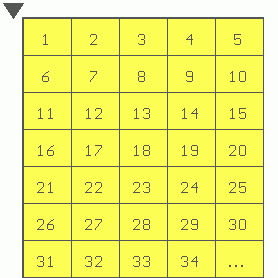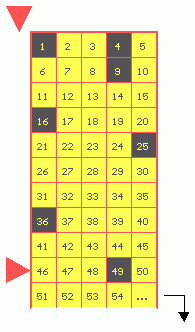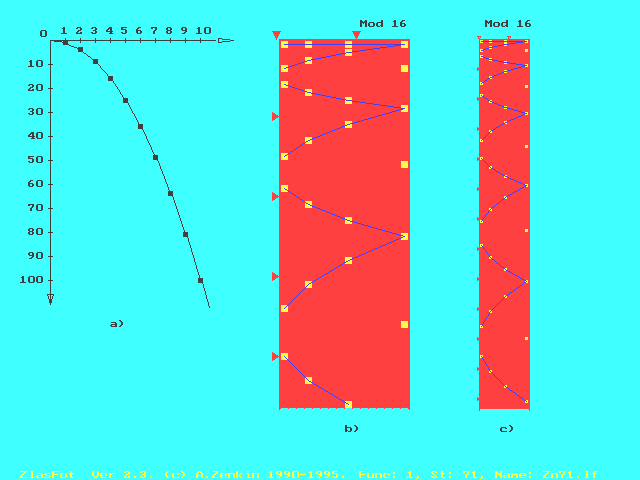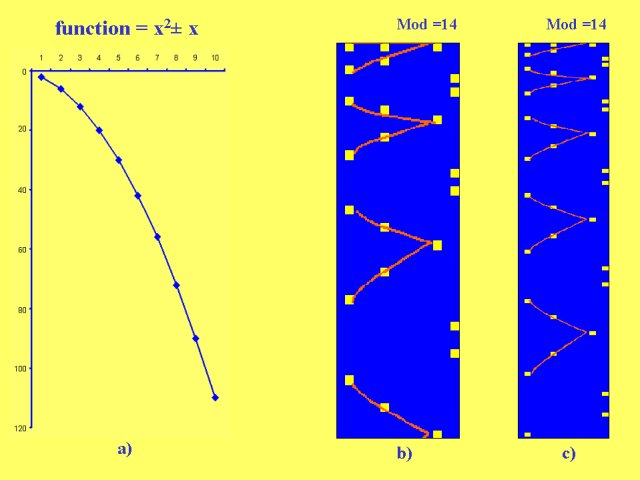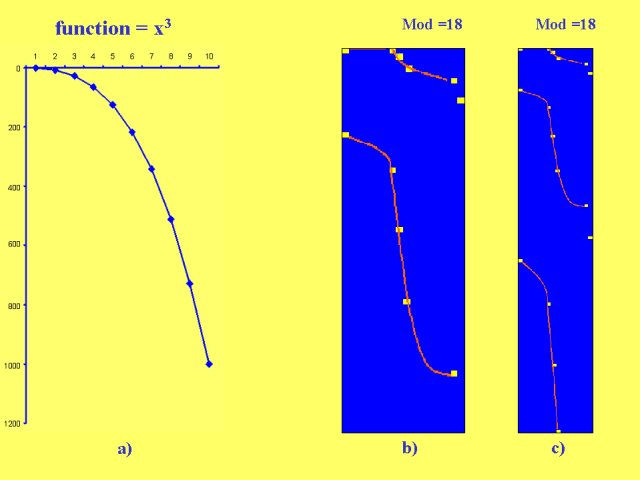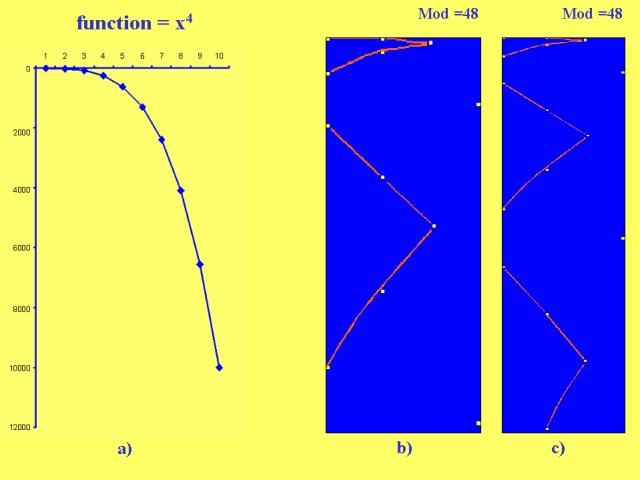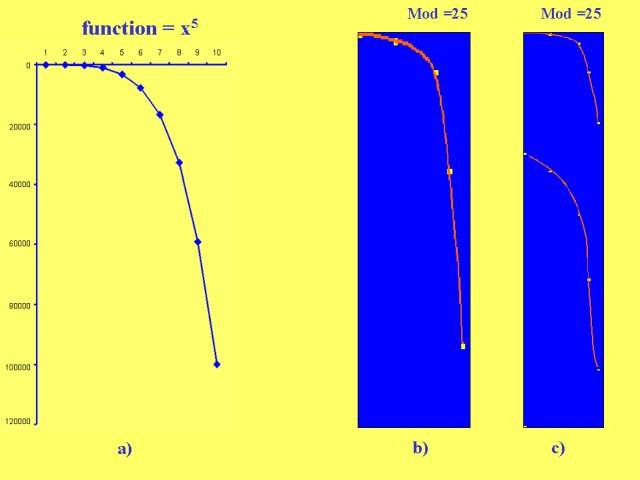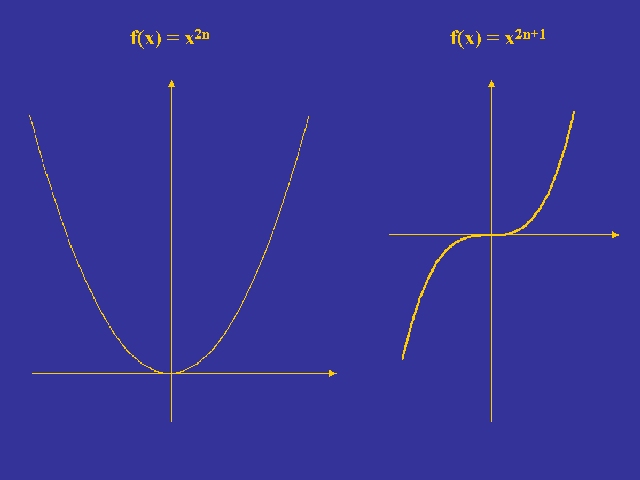COGNITIVE
VISUALIZATION OF SOME INTEGER - VALUED POLYNOMIALS
Emiliano
Ippoliti
University
of Rome - "La Sapienza"
e-mail:
e.ippoliti@srd.it
Visualization is
a powerful device in scientific discovery and in conjecture's formulation and
it has an increasing number of techniques and applications, revealing its
cognitive and heuristic power.
A.A. Zenkin [Zenkin 1991] has found an interesting
new propriety of square numbers, 1, 4, 9, 25,..., f(x) = x2, x ÎN, using
the so called phytograms, a cognitive and interactive visualization of
number-theoretical proprieties.
In this paper I am going to show how such new graphical representation of
number-theoretical objects can lead to find some new proprieties and formulate
two analytical conjectures.
It will be shown, in particular, how visualization is essential to find new
proprieties about some natural numbers series generated by integer-valued
polynomials, i.e. f(x) = ax2 ± bx ± c, where x, f(x), a, b, cÎN, and f(x)
= xn, i.e. f(x) = x2n+1 and f(x) = x2n where
x,n,f(x), n ÎN.
In §1 I will give a short introduction and will briefly
describe Zenkin's result and his visualization's devices (CCG - Cognitive
Computer Graphics).
In §2
and §3 we will present our visual results and conjectures
about the above polynomials.
§2 Visualization of second –
degree integer - valued polynomials
§2.1 A first general conjecture
§3 Visualization of even and
odd integer series
§3.1 A second general
conjecture
Visualization is traditionally seen (e.g. [Hadamar
1945]) as a valid mean of discovery, integrative or alternative to
formalization and deduction, and as a powerful device in conjecture's
formulation in mathematics. In fact not only it has an increasing number of
techniques and plays a main role in many mathematical domains, like number
theory, (see [Borwein and Jörgenson
1997], [Goetgheluck 1993], [Zenkin 1990]), but it is also the focus of
epistemological ([Giaquinto 1994], [Giaquinto 1993]) and philosophical ([Brown 1997], [Horgan 1993]) debates.
Vision uses in fact very different cognitive processes from formal and
abstract ones - i.e. geometrical construction and gestalt principles,
recognition of patterns, space symmetries, etc. – that are able to induce data
organization that lead to find new, unexpected mathematical proprieties and
formulate fruitful conjectures.
Moreover my results are going to show how it lays not simply on something
like direct perception, but how it needs some kind of “interpreting”.
Problem solving, hypothesis’s and conjectures formulation and mathematical
discoveries in fact often arise from change of codification of knowledge, both
formal both graphical: this apparently simple transformation allows in fact to
treat mathematical problem or concept like an object in a open conceptual
system [Cellucci 1998, Cellucci
1992], where its many, different, codification cooperate and interact
during the solution or discovery process.
In number theory, however, is well known how visualization of figurate
numbers (i.e. triangular numbers, squares numbers, pentagonal numbers, etc.)
heavily helps Pythagoras to find beautiful and relevant arithmetical laws.
Thus
it seems to be no doubt, in general, on heuristic nature, and power, of
visualization. So the real question seems to be: can visualization be a mean of
discoveries of analytical truth? can it, finite and empirical, allow to find
evidences for infinite and abstract processes?
There are, obviously, notorious and traditional limits of visualization that
can be adduced as strong arguments against not only its heuristic role, but
also its local, naïve and didactic use: the number of data that can be
visualized, the few available dimensions, the empirical nature are often really
big theoretical and practical obstacles of images, that can do us error steps
or lead to false inference (see e.g. [Brown 1997] the case of four circles in dimension n,
for n>10).
Moreover
visualization seems to bring to mind only single cases and particular examples,
that are unable to reach the abstractness and the generality necessary to
create new, relevant mathematical knowledge.
Giaquinto ([Giaquinto 1994], [Giaquinto 1993]) argues nevertheless that
visualization allow inner experiments and can make emerge both schemes (of
operations or analytical proofs) and the possibility of certain relationship at
least in arithmetic and in elementary real analysis:
But there is a more radical and fine
question about visualization, that has obviously only limitative and local
answers, if any.
It obviously doesn’t mean that every mathematical concept or idea has a
specific visual representation, but rather that is possible in some way to
express graphically concepts, solvability’s conditions, terms and relationship
ofproblems and concepts.
In this paper I first of all try to give a positive, but very local,
answer to above questions, showing with some examples in number theory how just
cognitive visualization is not a superfluous "correlate" of
mathematical thought, but how it can play an essential and cognitive role in
mathematical discovery's process.
It is worth noting that number theory isn’t a casual choice: numbers in
fact, as noted by [Giaquinto 1993], seem to be
pure abstract objects, entities that are also potentially not visualizable.
Then I will try to illustrate how visualization and images can be not
only a valid means of discovery and creation of new knowledge, but also how it
can allow to overcome some limits of formalist and deductive approach in
mathematics.
A.A. Zenkin [Zenkin
1991] found an interesting and unexpected propriety of square numbers 1, 4,
9, 25, ..., f(x) = x2, ÎN, using a visual representations called phytograms - a kind of cognitive
computer graphics (CCG).
Phytograms are a way to build a new kind of visual representations of
number theoretical proprieties - a new codification of knowledge - : they
visualize in a bi-dimensional table a discrete domain and create visual objects
that can be studied visually, interactively and in a "virtual
geometry" environment.
To construct a phytogram, first of all, we rewrite the 1D-sequence 1, 2,
3, 4, 5,..., n, nÎN, in the following 2D-form (see Figure 1):
Figure 1
Let the
modulus (mod) be the quantity of numbers-cells in every string of the phytogram
(in the example given in Figure 1, so, mod = 5).
Now we can choose any propriety of natural numbers, expressed by a predicate
P(n), and visualize it on a phytogram according to the following rule:
if P(n) is true, then the color of the n-th
cell is, e.g., black, else
if P(n) is false, then the color is, e.g.,
yellow
Let P(n)
= "to be or not be a square of a natural number" , n = x2: for mod = 5 we obtain
the following pythograms – e.g. by Zenkin [Zenkin
1991] – (see Figure 2):
Figure 2
The phytogram
is able to show the twice abstract connection between two main proprieties of
number theoretical objects - the additive and multiplicative.
The former is expressed by the colors of the phytograms , the latter by the
position, since all numbers n, for which n = (k x mod) + j, j < mod,
holds, are in the same j-th column of the pyhtogram.
Increasing
or decreasing the modulus, we obtain several configurations (structures) of the
same number - theoretical propriety P(n) that can be a useful heuristic
device: at the beginning we can obtain disordered sets of, e.g., black and
yellow points, but often we can see sets showing certain loop or structures
that, suitably interpreted, reveal very interesting patterns or models.
For ‘suitably interpreted’, we means that such patterns are not simple,
direct "data", but that they often emerge by, and need, a
"see" able to find analogies, links and correspondences between
a phytogram's set of points and space structures of other scientific
disciplines or mathematical domains (like geometry, biology, etc.).
Using a
famous Wittgenstein’s distinction [Wittgnestein
1953], when we observe images, like phytograms, and give them a sense, we
are always in a “see as” not simply in a “see”.
So just using CCG and
suitable visual interpreting A.A. Zenkin [Zenkin 1991]
has found a "beautiful and unexpected" propriety of square numbers 1,
4, 9, 25, ..., f(x) = x2, x ÎN, that reveals a
transformation not known in modern mathematics.
In fact for mod = 16, the single but infinite parabola x2 , see Figure
3a, became an infinite family of finite parabolas, Figure
3b-c, that can be formalized - as easily verifiable - in the following way:
Y#(n) = (8n ± k)2 , nÎN, k = 0,1,2,3,4.
As can be seen in Figure 3 each parabolas has nine
points that are squares of successive natural numbers.
Figure 3
We can
formalize and express analytically the family by associating a local coordinate
system to the pythogram (as shown in Figure 4); thus,
we have Y#(n) = (8n ± k)2 , nÎN, k = 0,1,2,3,4
where each point n is a parabola number: in fact the value of Y#(n)
here is not a usual number, but the sequence of following nine squares of
successive natural numbers (8n-4)2 , (8n-3)2
, (8n-2)2 , (8n-1)2 , (8n)2
, (8n+1)2 , (8n+2)2 , (8n+3)2
, (8n+4)2 for n = 0,1,2,3...
So the
infinite family of finite parabolas is the following infinite sequence of
9-points parabolas: Y#(0), Y#(1), Y#(2), Y#(3), ... Y#(n).
Figure 4
§2 VISUALIZATION OF SECOND
- DEGREE INTEGER - VALUED POLYNOMIALS
Zenkin's result shows how the main geometrical structure of the square
numbers series - i.e. the parabola - appears both in Cartesian representations
and in CCG - space (so the main structure remains unvaried), revealing a new
connection between finiteness and infiniteness.
We found an interesting similarity w.r.t. phytogram of x2 visualizing
two natural numbers well-known series: the so called
"etheronomechial" and "planic" numbers, respectively n
= x2 - x and n = x2 + x, both geometrical
parabolas (instance of polynomials of form f(x) = ±ax2 ± bx
± c).
It is worth noting that we will consider only integer-valued polynomials
(generating integer numbers series), that satisfy the conditions x > b,
x2 > c, -ax2 < ± bx ± c, ax2
> ±bx ± c: so x2 + x and x2 – x express the
same series and in general dual polynomials express the same series (e.g. x2
+ 4x generates the same series of x2 - 4x, because we consider, for
the latter, only x’s values > 4, generating integer natural numbers).
The predicate used to construct the phytograms is therefore P(n) = 'to
be or not be a planic/heteronomechial number".
For mod = 14, as shown in Figure 5, the series
became an infinite family of finite parabolas, each of 8 points that are successive
planic (etheronomical) numbers, such that for every nÎN, k = 0,1,2,3 , holds Y#(n) = (7n ± k)2 +
(7n ± k), or (7n ± k)2 - (7n ± k),
where, for n³1, -k = 4, and for, n = 0,
obviously we consider only positive values of ± k in the second member of
the equation.
Figure 5
Here we have again a single but infinite parabola that
became an infinite family of finite parabolas, trough the same connection
between infiniteness and finiteness from Cartesian system to CCG - space of
square numbers series.
This result lead us to extend the visual study to natural numbers series
that are generally expressed by parabolas, say second – degree integer – valued
polynomials, n = ax2 ± bx ± c, a,b,c,x,nÎN.
In Table 1 we summarized only some results reached
visualizing numbers series generated by such polynomials and shows how for this
cases always exists a mod's value such that the transformation holds.
Table 1
|
|
Mod |
Equation |
Points |
Structure |
|
y = x2+x |
|
Y#(n) = (7n ± k)2+ (7n ± k) , nÎN, k = 0,1,2,3 and, for n³1, -k= 4 |
|
Infinite
family of finite parabolas |
|
y = x2- x |
14 |
Y#(n)
= (7n ± k)2- (7n ± k), nÎN, k = 0,1,2,3 and, for n³1, -k= 4. |
|
Infinite
family of finite parabolas |
|
y = x2+2x |
16 |
Y#(n) = (6n± k)2+ 2(6n±k), |
9 |
Infinite
family of finite parabolas |
|
Y = x2+x+2 |
10 |
Y#(n) =
(4n ± k)2+ (4n ± k) + 2 ,nÎN,k = 0,1,2 and,
for n³1, +k = 3. |
6 |
Infinite
family of finite parabolas |
|
Y = x2+x+1 |
14 |
Y#(n) =
(7n ± k)2+ (7n ±k) + 1, |
8 |
Infinite
family of finite parabolas |
|
Y = ax2 |
a x 16 |
Y#(n) = (a8n - k)2, nÎN, k = 4,3,2,1,0 |
a x 8 |
Infinite
family of finite parabolas |
|
... |
... |
... |
... |
... |
The above visual observations and results suggest the following conjecture:
given any natural number series generated by polynomials of he form n = ax2
± bx ± c, a,b,c,x ÎN, there always will be a mod's value such that exist an infinite family
of finite parabolas, each of j ± k points, expressed by an equation of the
form a(jn ± k)2 + b(jn ± k)+
c, a,b,c,j,k,n,xÎN.
It means that it will always possible to express a series n = ax2
± bx ± c in the form a(jn ± k)2 + b(jn
± k)+ c and represent the single, infinite, Cartesian
parabola like an infinite family of finite parabolas in CCG - space.
More formally:
(I) "(ax2 ± bx ± c), a,b,c,x ÎN,$ mod s.t. $ infinite family of
finite ax2 ± bx ± c of form Y#(n) = a(jn
± k)2 + b(jn ± k)+ c
where a,b,c,j,k,n,xÎN and j ± k =
points of single finite ax2 ± bx ± c.
It is worth noting
that such transformation holds reversing the relationship between finiteness
and infiniteness, and we will see how it will play a main role also in
formulation of our second conjecture.
§3 VISUALIZATION OF EVEN
AND ODD INTEGER SERIES
For mod = 18, see Figure 6, we obtain a really
interesting result: like x2, in fact, here we have a single, finite,
infinitely iterated structure.
Figure 6
Unexpectedly
the shape of iterated finite structure is exactly a cubic, and the infinite
family is expressed, in the local coordinate system, by the equation Y#(n)
= (6n - k)3 , nÎN, k = 5,4,3,2,1,0,
where each cubic n has six points, successive cubes of natural numbers,
(6n-5)3 , (6n-4)3 , (6n-3)3
, (6n-2)3, (6n-1)3 , (6n)3.
Thus, like x3, by the single cubic series 1,8,27,..., x3
we obtain an infinite family of finite cubics.
So for n = 2 and n = 3, we have two similar and interesting
results for series of natural numbers of the form xn , x,n ÎN.
Visualization of successive values of n in xn
reveal not only a strong similarity w.r.t. this results, but will also lead us
to formulate a successive conjecture.
Let
begin by n = 4, phytograms with P(n) = "to be or not to
be a bi-square of a natural number".
Visualizing the bi-square series 1, 16, 81, 256, ... , x4,
x ÎN, in fact, we obtain, for mod = 48, (see Figure 7a) another space configuration similar to the previous:
an infinite family of finite parabolas - having obviously a greater concavity
than the square numbers series -, each of 7 points successive bi-squares of
natural numbers (4n - 3)4 , (4n - 2)4, (4n
- 1)4 , (4n)4 , (4n + 1)4 , (4n
+ 2)4 , (4n + 3)4, expressed in local coordinate
system by the equation Y#(n) = (4n ± k)4, nÎN, k = 0,1,2,3.
For n = 5 indeed, P(n) = "to be or not to be a fifth
powers of a natural number", we obtain an interesting visualization
similar to n = 3 (see Figure 7b).
The series of fifth powers of natural numbers 1, 32, 243, 1024, ... , x5,
x ÎN, shows again, for mod =25, an infinite family of
finite structures that resemble cubics, each composed of 5 points, successive
fifth powers of natural numbers, (5n - 4)5 , (5n
- 3)5 , (5n - 2)5 , (5n - 1)5
, (5n)5, expressed by the equation Y#(n) = (5n
- k)5 , nÎN, k = 4,3,2,1,0.
The series assumes, in detail, the typical course of odd functions: this visual
fact, on the base of the results summarized in Table 2,
suggests the conjecture of the following paragraph.
Figure 7b
|
|
Mod |
Equation |
Points |
Structure |
|
Y = X2 |
16 |
Y#(n) = (8n ± k)2, nÎN, k = 0,1,2,3,4 |
9 |
Even structure: infinite family of finite
parabolas - Fig. 3 |
|
Y = X3 |
18 |
Y#(n) = (6n - k)3, nÎN, k = 5,4,3,2,1,0 |
6 |
Odd structure: infinite family of finite cubics
- Fig. 6 |
|
Y = X4 |
48 |
Y#(n) = (4n ± k )4, nÎN, k = 3,2,1,0 |
7 |
Even structure: infinite family of finite
parabolas Fig. 7a |
|
Y = X5 |
25 |
Y#(n) = (5n - k)5, nÎN, k = 4,3,2,1,0 |
5 |
Odd Structure: Infinite family of finite fifth
powers - Fig. 7b |
|
... |
... |
... |
... |
... |
As known, even and odd functions, f(x) = xn, x, nÎN, for n > 1 and respectively n = 2p and n = 2p+1,
have typical and different courses in Cartesian plane (see Figure
8).
Figure 8
It seems plausible to suppose that such transformation holds for every odd
and even series.
It means that it will always be possible to represent a single, infinite,
odd/even series of natural numbers like an infinite family of finite,
respectively, odd/even structure, expressible in the form Y#(n) = (an
± k)N N ,a ,k,n,ÎN, a ± k = number of
points of single finite structures.
More formally:
(II) " xn, x,n ÎN, $ mod s.t. $ infinite family of finite
xn of form Y#(n) = (an ±k)N N ,a ,k,n,ÎN,
where a ± k = number of points of single finite xn that
have, for n = 2p and n = 2p+1, respectively an even and odd
structure.
Concluding it
is worth noting that:
(a)
both conjectures have an existential form ( For every …it exist a
mod’s value such that …): they look for at least a single mod’s value that
satisfy the propriety.
Obviously visual inspection of
number theoretical proprieties can assume an universal form. In fact we can
look for invariants (also topological) that occur in every mod’s value (i.e. in
every phytograms): given a number theoretical relationships, we can thus look
for proprieties of form “ for every mod’s value it exist a etc. etc.”
(examples of such kind are given in [Zenkin 1999 ]).
(b)
their formulation strictly depends on visualization, that enable us to
see and construct space relationships and patterns that suggest their
recognition.
CONCLUDING REMARKS
"Mathematics can be described as a ‘science of patterns’, pursuing
patterns, relationships, generalized descriptions and recognizable structures
in space, numbers, and others abstracted entities"([Borwein and Jörgenson 1997], pag.1).
The above
results have been reached applying a methodology and a heuristic approach
(typical of visual thinking) that is not really usual in a very abstract,
formalized and traditional domain like number theory.
In fact it visually looks for such patterns and relationships overriding
the formalist and deductive way: it takes a number theoretical series,
expressed by a sentence P(n) and by its own representation in Cartesian
plane, and change visualization’s system by phytograms.
In particular, interaction with
visual facts (values of mod’s phytograms) led us to find (see) some patterns
that we tried to recognize analogically in similar integer numbers series to
obtain a more general conjecture and formal proprieties.
Then, founded such correspondences, we use ordinary formal devices to
formulate inductively two general conjectures that seem to specify new
interesting proprieties of such integer numbers series.
We noted that visualization is essential to reach this results: it is
impossible to obtain them applying ordinary formalist and deductive tools, unable
tosuggest the existence of such transformations form Cartesian to CCG - space.
Although it is a not conventional methodology, cognitive computer
visualization (CCG) by phytograms is a new fruitful way of study and interact
with number theoretical objects that can be successful applied, as heuristic device,
in discrete domain and that can be very useful not only in modern [Zenkin 1990], but also in long standing number -
theoretical problems.
I mean that cognitive visualization allow to study and interact with - number
theory in several ways, looking for both existential and universal theorems and
conjectures, and show how visual thinking and visual procedures can be not only
a powerful resource, but often an absolute necessity for mathematical
creativity.
I would like to thank prof. A.A.
Zenkin for his precious advices and doc. U. Rustichelli for his help in
software development under Linux.
REFERENCES
[Hadamar 1945] The psychology of invention, Jacques
Hadamar, Princeton University Press, 1945
[Goetgheluck 1993] Fresnel zones on the screen ,
Pierre Goetgheluck, Experimental mathematics, Vol. 2 , 1993, No. 4, pagg.
301-309.
[Zenkin 1990] Waring's problem from the standpoint of
the cognitive interactive computer graphics , A.A.Zenkin , An International
Journal - Mathematical and Computer Modeling, Vol.13, No. 11, pp. 9 - 25, 1990.
[Zenkin 1991] Cognitive Computer Graphics.
Applications in Number Theory, A.A. Zenkin, Moscow: "NAUKA",
PhysMath. Literature, 1991, 191 pp.
[Zenkin 1999] [Zenkin 1999] Virtual Geometry of Natural Numbers, http://www.com2com.ru/alexzen/papers/vgeom/vgeom.html
[Brown 1997]
Proofs and pictures , J.R. Brown, Brit. J. Phil. Sci., 48:161-180, 1997.
[Giaquinto 1994] Epistemology of visual thinking in
elementary real analysis, Marcus Giacquinto, Brit. J. Phil.
Sci., 45, 1994.
[Giaquinto
1993] Visualizing in Arithmetic, M. Giaquinto, Phil. Phenom. Research, 1993.
[Horgan 1993] The death of proof, John Horgan, Scientific
American, 269, n.4, October 1993.
[Cellucci 1998]
"Le ragioni della logica", Carlo Cellucci, Laterza, 1998, 420
pp.
[Cellucci 1992] "From closed to open
systems", Carlo Cellucci, Proc. of th 15th International
Wittgenstein-Symposium, Czermak, 1992, pagg. 206-220.
[Wittgnestein 1953] “Philosophische Untersuchungen“,
L. Wittgenstein, (1953), Philosophical
Investigations, translated by G. E. M. Anscombe, 3rd edition, 1967, Oxford:
Blackwell
